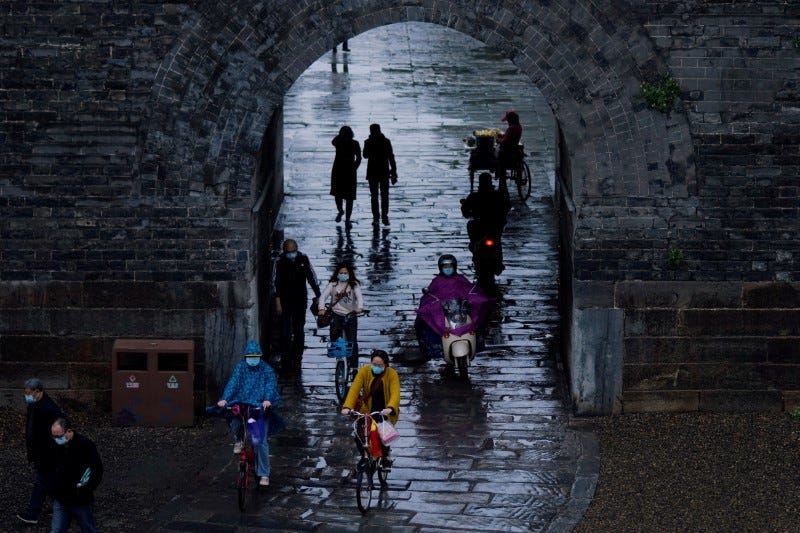- Life is slowly returning to normal in the Hubei province in China, after its government announced on March 25 that it would lift travel restrictions on residents after more than two months of lockdown.
- Millions of people will now be able to travel to places within and outside the province again, as long as they’ve been given a “green code” by a health-tracking device on their phones.
- Public transport in major cities started operating again and hundreds of tourist sports in the province have also reopened.
- But residents, as well as experts, are fearful that the virus will re-emerge as people start going back to work and public places become available.
- Photos show what life is like on-the-ground for residents of the Hubei district, who are slowly getting used to life outside their homes again.
- Visit Insider’s homepage for more stories.
All eyes are on Hubei, China, the one-time of the coronavirus outbreak, after it announced on March 25 that it would start lifting travel restrictions on its residents after months of lockdown.
The provincial government said that this would apply to all cities in the Hubei province except for Wuhan, which will remain under lockdown until April 8.
This change means tens of millions of people will be able to travel to places within and outside the province again, as tourist attractions and shops start opening their doors again.
But the move has been questioned by experts as well as residents, who fear that the virus might come back, a phenomenon known as the “boomerang effect.”
Hopeful photos show what life looks like in Hubei as people start to leave the confines of their own homes and start living life outside again.
After more than two months of intense lockdown, the Hubei province in China lifted its travel restrictions on March 24.

This means that residents are allowed to travel outside and inside the province, but only if they have a "green code" health designation.

Source: The Guardian
People's health can be tracked in an app on their phone, which has an individual's health status linked to it.

Wuhan, where the virus originated, is the only city in the province that is still on lockdown until April 8.

Source: Business Insider, New York Times
The news comes amid a significant reduction in new infections in the province, as no new cases were recorded for five consecutive days from March 19.

On March 24, one new confirmed case was reported in Wuhan, which was a doctor at the Hubei General Hospital, CNN reported.
Two makeshift Wuhan hospitals and other temporary centers, which were hastily built to accommodate more patients, closed their doors on March 10.

The city of Wuhan rushed to build two hospitals in early February, both of which were done in a matter of weeks.
Source: The Guardian
Medical staff who came from other provinces to help in major hospitals in Wuhan have also returned home.

Source: Reuters
Meanwhile, regular hospitals have been disinfected as staff prepares them for the resumption of their normal services.

Source: Reuters
Around 130 tourist attractions, like the ancient city wall in the city of Jingzhou, have also opened to the public again.

Source: South China Morning Post
But officials are still being careful. Sites have been disinfected and visitors to the city wall in the city of Jingzhou, for example, still have to get their temperatures checked before entering.

Some tourism spots in the higher risk areas remain closed, according to South China Morning Post.
Meanwhile, thousands of people have been allowed to return to their daily lives.

Those that have been cleared by their health-tracking app are starting to resume work, like this taxi driver...

...and others are making use of the re-opened public transport system.

But while the province is experiencing some freedom again, many are still too scared to leave home.

Steven Hsu, who is living with his family in Xiaogan, told the Guardian he still feared the risk of infection from people who were asymptomatic, which is why he is choosing to stay at home for a while.

Source: The Guardian
Another woman from Xiaogan told the same paper that she is still waiting to travel to see her boyfriend because "travel is actually very risky."

Source: The Guardian
Locals are not the only ones who are scared. Experts also fear that the virus could come back, in a phenomenon called the "boomerang effect."

Dr. Ben Cowling, an epidemiologist at the University of Hong Kong told Business Insider's Morgan McFall-Johnsen and Holly Secon that the boomerang effect means that a second wave of the virus could hit the province either by a small number of residents who don't know they're sick and spread it or by international travelers who bring it in from other countries.
Experts are also worried that China is loosening its restrictions too early in an effort to restart the economy.

Source: The New York Times
Chinese premier Li Keqiang has warned local governments not to cover up new cases of COVID-19 "for the sake of keeping new case numbers at zero."

Source: The Guardian
He also warned that even though cases in the provinces have almost stopped, there is still a significant risk that the virus will have occasional outbreaks.

Source: The Guardian
Meanwhile, the rest of the world is looking on in anticipation. Much of the world copied Hubei's lockdown, and want to see proof that it works.

